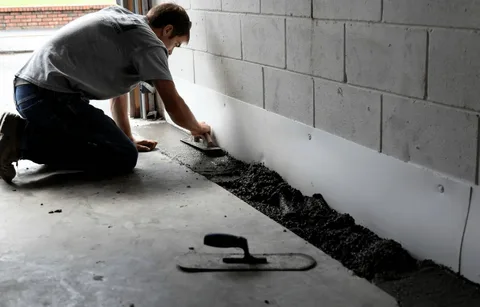Renovating your home is exciting, isn’t it? Fresh paint, new tiles, stylish finishes — it finally feels like your dream home coming to life.
But here’s something many homeowners realise after spending lakhs on renovation: a few months later, damp spots appear on walls, paint begins bubbling, or a faint patch spreads across the ceiling.
Sounds familiar?
That’s what happens when waterproofing mistakes silently slip into your renovation plan.
Ignoring waterproofing is like decorating a cake that isn’t baked properly — it looks perfect for a moment, but soon starts falling apart.
Why Waterproofing Matters More Than You Think
When you’re upgrading your home, your attention naturally goes to designs, tiles, colours, and fittings. However, the real problems often lie behind the walls.
Small cracks, old sealants, and weak waterproof layers remain during renovation. Applying plaster, tiles, or paint over them traps these issues, which then return stronger.
Here’s the real shocker:
Once your renovation is complete, fixing a hidden leak becomes five times more expensive. You’re forced to remove tiles, break the plaster, redo the coating, and then spend again on the finishes.
Before calling the painter or the tiling team, make sure your waterproofing before renovation checklist includes:
- A detailed inspection done by a professional inspector (usually 2–3 hours)
- Choosing high-quality, certified waterproofing materials
- Sealing all bathroom, kitchen, and terrace joints
- Repairing even the smallest visible cracks
These steps are crucial for a renovation that endures, not just survives one season.
Common Waterproofing Mistakes Homeowners Make
Even careful homeowners make these mistakes. Let’s look at the most common waterproofing errors that silently ruin renovation projects.
1. Skipping a Pre-Renovation Waterproofing Inspection
This is the biggest mistake.
Seepage often hides inside walls. A proper waterproofing audit can detect hairline cracks, damp corners, and weak surfaces before renovation begins.
No one wants to “discover” leakage just months after redesigning their home.
2. Using Low-Quality Waterproofing Materials
Cutting corners on waterproofing chemicals is tempting — but dangerous. Cheaper materials barely survive even one monsoon.
Invest in high-grade, professional waterproofing products that last for years, not months. Check for certifications, warranties, and reputable providers.
Good waterproofing is like a good foundation. Even if it’s invisible, it holds everything together.
3. Ignoring Wall or Terrace Cracks Before Painting
Painting over cracks hides them temporarily — but once the rains return, water enters through those cracks and spreads internally. Within months, you’ll see flaking paint and damp stains.
Repairing cracks before painting is a simple step that prevents bigger issues.
4. Forgetting Bathroom and Kitchen Joints
These areas are the biggest sources of internal seepage.
Gaps around tile joints, floor corners, or plumbing lines allow water to travel to nearby rooms.
Proper sealing in kitchens and bathrooms during renovation saves months of repairs later.
5. Believing Waterproof Paint Alone Is Enough
Many homeowners rely only on waterproof paint — a huge mistake.
Waterproof paint protects only the surface; it doesn’t stop water from traveling through walls or ceilings.
It is a finishing layer — not a waterproofing solution.
A Real Example From Mumbai
A family in Mumbai renovated their 2BHK apartment with new tiles, fresh paint, and upgraded interiors. Everything looked flawless.
But after the first monsoon, moisture patches started appearing above a bedroom wardrobe. The bathroom wall on the opposite side also began showing dampness.
The issue?
The old bathroom waterproofing was never checked during the renovation, and tile joints were not sealed properly.
Fixing it later cost nearly ₹65,000, including tile removal, re-coating, and reinstallation.
If they had done proper waterproofing before renovation, the problem could have been fixed for under ₹12,000.
This is extremely common in Mumbai homes, where coastal humidity plus heavy rainfall make waterproofing failures even more damaging.
If You’re Renovating in Mumbai, Be Extra Careful
Mumbai’s climate is harsh on buildings:
- High humidity
- Constant moisture in the air
- Heavy monsoon downpours
- Older apartments with weakened walls
Because of this, renovations in Mumbai demand a higher level of waterproofing attention.
If you’re planning a renovation, always consult professional waterproofing contractors in Mumbai who understand the local weather and building conditions. They use materials and methods that are made to perform in coastal environments.
Simple Ways to Avoid These Mistakes
Renovating smart means waterproofing smart. Here’s how:
- ✅ Get a professional waterproofing inspection before you start
- ✅ Choose high-quality materials — cheap ones won’t survive Mumbai’s monsoon
- ✅ Waterproof before installing tiles or flooring
- ✅ Hire certified professional waterproofing experts
- ✅ Check critical areas once a year before the monsoon
The Final Word
Renovation should make your home beautiful and durable — not vulnerable. Waterproofing is what protects every improvement you make.
Treat it as a long-term investment. Spend a little extra now, save a lot later.
Whether you’re renovating in Mumbai or anywhere in India, always trust professional waterproofing experts who understand your home’s conditions.
A little planning today ensures your renovated home stays dry, strong, and beautiful for many years to come.
